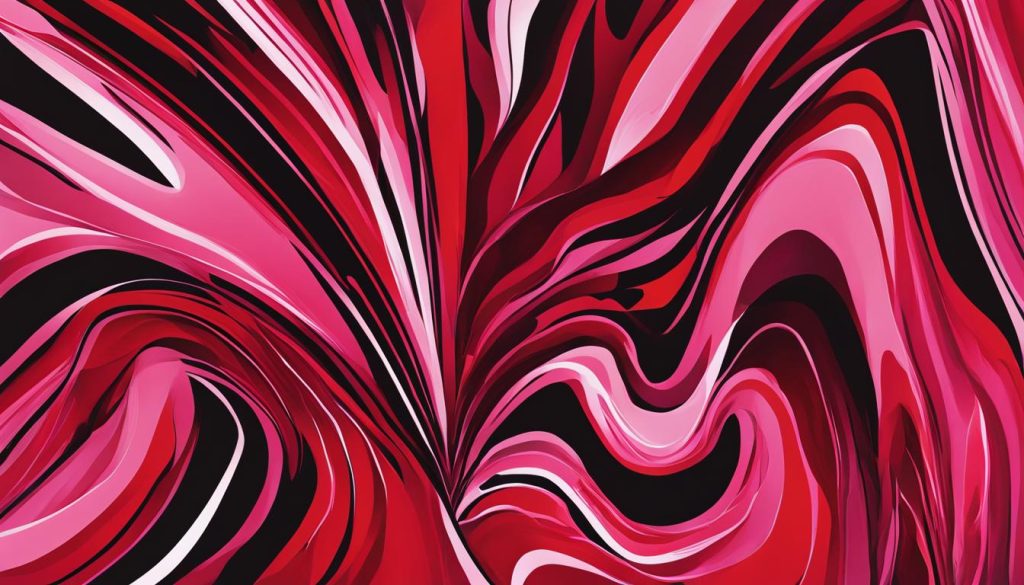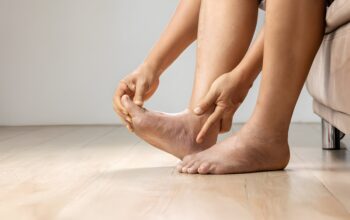If you’re experiencing clitoral pain, you’re not alone. Many women wonder, “Why does my clit hurt?” Clitoral pain can be a distressing and uncomfortable experience, but understanding the causes and available treatments can help you find relief.
Key Takeaways:
- Clitoral pain can be caused by various factors, including hormonal deficiencies, infections, surgical scars, and vulvar diseases such as Lichen Sclerosus.
- Conditions like pudendal neuralgia and pelvic floor dysfunction can also contribute to clitoral pain.
- Treatment options may include addressing the underlying cause, pelvic floor physical therapy, home exercises, and proper hygiene.
- Consulting with a vulvar health expert may be necessary for effective treatment.
- Remember, clitoral pain is treatable, and with the right approach, you can find relief and improve your overall well-being.
Treatable Causes of Clitoral Pain
There are several treatable causes of clitoral pain. These include:
- Hormonal deficiencies: Hormonal imbalances associated with birth control pills and age can contribute to clitoral pain.
- Clitoral phimosis: This condition occurs when the clitoral hood becomes too tight, resulting in pain and discomfort.
- Vaginal and vulvar infections: Infections such as yeast infections and sexually transmitted infections can cause clitoral pain.
- Surgical scars: Scarring from previous surgeries, such as vaginal or vulvar procedures, can lead to clitoral pain.
- Vulvar diseases: Conditions like Lichen Sclerosus can cause inflammation and pain in the clitoral area.
Identifying and addressing the underlying cause is crucial for effective treatment of clitoral pain. Treatment options may include:
- Pelvic floor physical therapy
- Home exercises for tissue mobility
- Proper hygiene practices
Consulting with a vulvar health expert is recommended if the underlying cause is not identified or if the pain persists despite treatment. They can provide specialized guidance and recommend additional interventions if needed.
Summary of Treatable Causes of Clitoral Pain
| Cause | Description |
|---|---|
| Hormonal deficiencies | Associated with birth control pills and age |
| Clitoral phimosis | Tightening of the clitoral hood |
| Vaginal and vulvar infections | Infections such as yeast infections and STIs |
| Surgical scars | Scarring from previous vaginal or vulvar procedures |
| Vulvar diseases | Conditions like Lichen Sclerosus |
Identifying and addressing the specific cause of clitoral pain is essential for successful treatment and relief. By targeting the underlying issue, individuals can work towards resolving their symptoms and improving their overall well-being.
Understanding Pudendal Neuralgia and Pelvic Floor Dysfunction
Pudendal neuralgia is a condition that occurs when the pudendal nerves in the pelvic region become irritated. This irritation can result in clitoral pain that is felt on one or both sides. Pelvic floor dysfunction, on the other hand, is a common issue associated with many pelvic pain diagnoses. It can cause pain to radiate to various areas, including the clitoris.
In order to diagnose pudendal neuralgia and pelvic floor dysfunction, healthcare professionals typically rely on a combination of medical history and physical examination. Understanding the underlying cause of these conditions is crucial for effective treatment.
Diagnosing Pudendal Neuralgia and Pelvic Floor Dysfunction
Diagnosing pudendal neuralgia and pelvic floor dysfunction involves a careful assessment of symptoms, medical history, and physical examination. This may include assessing pain patterns, conducting sensory testing, and evaluating pelvic muscle function. Additional diagnostic tests such as nerve conduction studies, electromyography, and imaging studies may be ordered to help confirm the diagnosis and rule out other potential causes.
It’s important to consult with a healthcare professional experienced in diagnosing and treating pelvic pain to ensure an accurate diagnosis and appropriate treatment plan.
Treating Pudendal Neuralgia and Pelvic Floor Dysfunction
Pelvic floor physical therapy is often recommended as a primary treatment approach for both pudendal neuralgia and pelvic floor dysfunction. This therapy aims to improve muscle function and relieve tension in the pelvic floor muscles, which can help reduce pain and improve overall pelvic health.
In addition to physical therapy, treatment options may include medications to manage pain and inflammation, nerve blocks to provide temporary relief, and psychological support to address any emotional or mental health concerns associated with chronic pain.
It’s important to note that each individual’s treatment plan may vary based on their specific symptoms and underlying causes. A comprehensive and multidisciplinary approach that combines medical interventions, physical therapy, and psychological support is often the most effective way to manage pudendal neuralgia and pelvic floor dysfunction.
Clitorodynia: An Abnormal Pain of the Clitoris
In some cases, clitoral pain can manifest as clitorodynia, which refers to an abnormal pain of the clitoris. This condition can cause significant discomfort and distress for individuals experiencing it. Clitorodynia can have various causes, including:
- Buildup of Keratin Pearls
- Skin diseases affecting the vulva
- Herniated disc or cyst in the spine
- Injury to the pudendal nerve
Understanding the underlying cause is crucial for effective treatment of clitorodynia. Treatment options for clitorodynia depend on the specific cause and may involve a combination of interventions tailored to an individual’s needs. These treatment options may include:
- Keratin Pearl excision to remove the buildup
- Medication such as tricyclic antidepressants or anticonvulsants to manage pain
- Utilizing pain relief measures to alleviate symptoms
It is important to consult with a healthcare professional who specializes in pelvic pain or vulvar disorders to accurately diagnose clitorodynia and create an appropriate treatment plan. By addressing the underlying cause, individuals experiencing clitorodynia can find relief and improve their overall quality of life.

Illustration depicting the clitoris, relevant to the topic of clitorodynia.
Common Causes of Clitoris Pain
Clitoris pain can be attributed to various factors, including irritants, infections, clitoral adhesions, lichen sclerosus, sexual abuse, and underlying nervous system conditions. Understanding the root cause is crucial in determining the appropriate treatment approach.
Irritants found in dyes and chemicals present in hygiene products can cause discomfort and pain in the clitoral area. It’s essential to be mindful of the products you use and opt for gentle, hypoallergenic options.
Infections, such as yeast infections and sexually transmitted infections, can also lead to clitoris pain. Prompt treatment with antifungals or antivirals is necessary to alleviate symptoms and promote healing.
Clitoral adhesions occur when the clitoral hood fuses with the clitoris, causing pain and discomfort. This condition may require medical intervention such as surgery or hormone therapy to relieve the adhesions.
Lichen sclerosus is a chronic inflammatory condition that affects the skin around the clitoris and the vulva. It can cause itching, pain, and scarring. Treatment may involve topical corticosteroids to reduce inflammation and manage symptoms.
Unfortunately, clitoris pain can also be the result of sexual abuse. Seeking therapy and counseling are essential for addressing the psychological effects and finding ways to cope with the pain.
Underlying nervous system conditions, such as pudendal neuralgia or pelvic floor dysfunction, can refer pain to the clitoris. It is crucial to identify these conditions through thorough medical evaluation and pursue appropriate treatments such as pelvic floor physical therapy or nerve stimulation techniques.
Addressing these underlying causes and managing their associated symptoms can help alleviate clitoris pain and improve overall well-being.
| Possible Causes of Clitoris Pain | Treatment Options |
|---|---|
| Irritants from hygiene products | Avoiding irritants, opting for hypoallergenic products |
| Infections (yeast infections, STIs) | Treatment with antifungals or antivirals |
| Clitoral adhesions | Medical intervention (surgery, hormone therapy) |
| Lichen sclerosus | Topical corticosteroids, symptomatic management |
| History of sexual abuse | Therapy, counseling, psychological support |
| Underlying nervous system conditions | Pelvic floor physical therapy, nerve stimulation techniques |
Diagnosing and Treating Clitoris Pain
When experiencing clitoris pain, an accurate diagnosis and appropriate treatment are essential for relief. Your healthcare professional will begin by conducting a comprehensive medical history and physical examination to determine the underlying cause of your pain. In some cases, further testing such as cultures and bloodwork may be necessary to identify any infections or underlying conditions.
Once the cause of your clitoris pain has been determined, your healthcare professional will recommend a tailored treatment plan. The specific treatment options will depend on the underlying cause, but may include:
- Antibiotics: If your clitoris pain is caused by a bacterial infection, your healthcare professional may prescribe antibiotics to combat the infection.
- Antivirals: If a viral infection, such as herpes, is the cause of your pain, antiviral medications may be prescribed to help manage symptoms.
- Antifungals: If a fungal infection, such as a yeast infection, is the culprit, antifungal medications can effectively treat the infection.
- Pain relievers: Over-the-counter pain relievers, such as ibuprofen or acetaminophen, may be recommended to alleviate discomfort and reduce inflammation.
- Pelvic floor physical therapy: In some cases, clitoris pain may be associated with pelvic floor dysfunction. Pelvic floor physical therapy can help strengthen and relax the muscles in the pelvic region, providing relief from pain.
- Sex therapy and counseling: If psychological factors, such as anxiety or trauma, contribute to your clitoris pain, your healthcare professional may refer you to a sex therapist or counselor who can provide guidance and support.
Remember, the exact treatment plan for clitoris pain will vary depending on your individual condition and needs. It is crucial to consult with a healthcare professional for an accurate diagnosis and appropriate treatment. Together, you can work towards finding relief from clitoris pain and improving your overall well-being.
| Diagnosing Clitoris Pain | Treating Clitoris Pain |
|---|---|
| Thorough medical history | Antibiotics |
| Physical examination | Antivirals |
| Cultures and bloodwork | Antifungals |
| Pain relievers | |
| Pelvic floor physical therapy | |
| Sex therapy and counseling |
Conclusion
Clitoris pain is a distressing condition that can significantly impact your quality of life. However, the good news is that many common causes of clitoris pain can be effectively treated, providing relief and improving your overall well-being.
The outlook for individuals with clitoris pain depends on identifying the underlying cause and finding the appropriate treatment. Seeking professional medical advice is crucial for an accurate diagnosis and tailored treatment plan. With the right approach, many people can find relief from clitoris pain and regain their comfort.
Remember, each person’s experience with clitoris pain is unique, and treatment outcomes can vary. It’s essential to be patient and maintain open communication with your healthcare provider throughout the treatment process. They will work closely with you to determine the best course of action and help you achieve the most favorable outcome.
FAQ
Why does my clitoris hurt?
Clitoral pain can be caused by various factors, including hormonal deficiencies, clitoral phimosis, vaginal and vulvar infections, surgical scars, and vulvar diseases such as Lichen Sclerosus. It can also be associated with pudendal neuralgia and pelvic floor dysfunction. Treatment options depend on the underlying cause and may include identifying and addressing the cause, pelvic floor physical therapy, home exercises for tissue mobility, and proper hygiene.
What are the treatable causes of clitoral pain?
Treatable causes of clitoral pain include hormonal deficiencies associated with birth control pills and age, clitoral phimosis, vaginal and vulvar infections, surgical scars, and vulvar diseases such as Lichen Sclerosus. Treatment involves identifying and addressing the underlying cause. Pelvic floor physical therapy, home exercises for tissue mobility, and proper hygiene may also be recommended as part of the treatment approach.
What is the connection between pudendal neuralgia and clitoral pain?
Pudendal neuralgia is a condition characterized by the irritation of the pudendal nerves, which can cause unilateral or bilateral clitoral pain. Pelvic floor dysfunction, which is associated with most pelvic pain diagnoses, can also refer pain to the clitoris. Diagnosis is typically made through a combination of history and physical examination, and treatment often involves pelvic floor physical therapy.
What is clitorodynia?
Clitorodynia, also known as abnormal pain of the clitoris, can be caused by a buildup of Keratin Pearls, skin diseases affecting the vulva, herniated disc or cyst in the spine, or injury to the pudendal nerve. Treatment options depend on the cause of the pain and may include Keratin Pearl excision, medication such as tricyclic antidepressants or anticonvulsants, and pain relief measures. Treatment plans are tailored to each individual’s specific needs and may involve a combination of interventions.
What are the common causes of clitoris pain?
Clitoris pain can be caused by various factors, including irritation from dyes and chemicals found in hygiene products, infections such as yeast infections and sexually transmitted infections, clitoral adhesions, lichen sclerosus, injury from sexual abuse, and underlying conditions that affect the nervous system. Identifying the underlying cause is important for determining the appropriate treatment approach, which may involve managing hygiene, treating infections, addressing skin conditions, and seeking therapy for psychological effects.
How is clitoris pain diagnosed and treated?
Diagnosing clitoris pain involves a thorough medical history, physical examination, and potentially further testing such as cultures and bloodwork. Treatment options for clitoris pain vary depending on the underlying cause and may include antibiotics, antivirals, antifungals, pain relievers, pelvic floor physical therapy, and sex therapy and counseling. It is important to consult with a healthcare professional for an accurate diagnosis and appropriate treatment.
What is the outlook for individuals with clitoris pain?
The outlook for individuals with clitoris pain depends on the underlying cause and the response to treatment. With the right approach, many people can find relief from clitoris pain and improve their overall well-being. It is important to seek professional medical advice for an accurate diagnosis and appropriate treatment.







